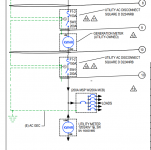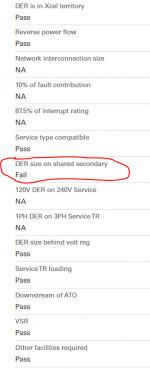@jaggedben @ggunn @BackCountry
I appreciate the discussion here guys -- but the word is back, and they already rejected the update w/ a disconnect on both sides of the meter. Now, maybe it is not rejected based on technical merit, but you'll like this.
---------
Comments from Approvers: Approver 2 Comment: This application has been rejected. Please correct the following before resubmitting:
One-Line:
3.21.1 - Other AC Disconnects shall not be labeled or identified as a “Utility” AC Disconnect, if applicable. With this design only a single AC disconnect should be distinguished as the 'Utility AC Disconnect.' The utility AC disconnect must be properly located according to
3.21.2 or 3.21.3.
Site Plan:
4.7 - Main service entrance, all meter locations, disconnects, transformers, proposed and existing DER systems. Please ensure any changes made to the One-line are made to the Site Plan as well.
-------------
Yes, In my one-line I had them both labeled as "Utility AC Disconnect" - and I can easily make a change here. But once again, this is annoying as there is no possible way to communicate with these folks on 'exactly what they want'! Here is the entire 3.21 section from their interconnection manual:
AC Disconnect
3.21 A visible‐open type, lockable, and readily accessible AC disconnect for purposes of isolating the DER from the utility source labeled “Utility AC Disconnect,” “Photovoltaic Utility AC Disconnect,” or similar shall be shown
3.21.1 Other AC Disconnects shall not be labeled or identified as a “Utility” AC Disconnect, if applicable Note: The “Utility AC Disconnect” must be accessible to Xcel Energy’s personnel 24/7 without escort, hindrance, or delay. Rack‐out/draw‐out breakers5 do not qualify as a “Utility” AC Disconnect.
3.21.2 For installations that require a Production Meter, the
Utility AC Disconnect shall be located between the DER and production meter
3.21.3 For installations not requiring a Production Meter, the Utility AC Disconnect shall be located between the DER and main service
3.21.4 When multiple DER units are existing or proposed on a single service: if a single Utility AC Disconnect cannot be used to disconnect all DER, all Utility AC Disconnects should include numerical identification such as “Utility AC Disconnect 1 of 2” or similar. The number of disconnects required to be operated to isolate the DER from the utility should be clear.
OK, so reading this to me sets off a few more things.. Firstly, they want me to change the name so that only one is labelled the Utility Disconnect. Fine. If that is the case, 3.21.2 is applicable and says the "utility ac disconnect" should be the
second disconnect in the one-line. What would the first one be called? Auxiliary PV disconnect ? and if so, am I reading that correct? The one on the supply side is not technically BETWEEN the DER and production meter...
Secondly, 3.21.3 seems unrelated here, as I have a production meter
Thirdly, 3.21.4 seems unrelated, as I don't have multiple DER units.
Thoughts?
Image is what I had... I also understand from the conversation that the second disconnect (whatever the heck you wanna name it) doesn't technically need to be fused. But at this point, it doesn't seem to matter.






